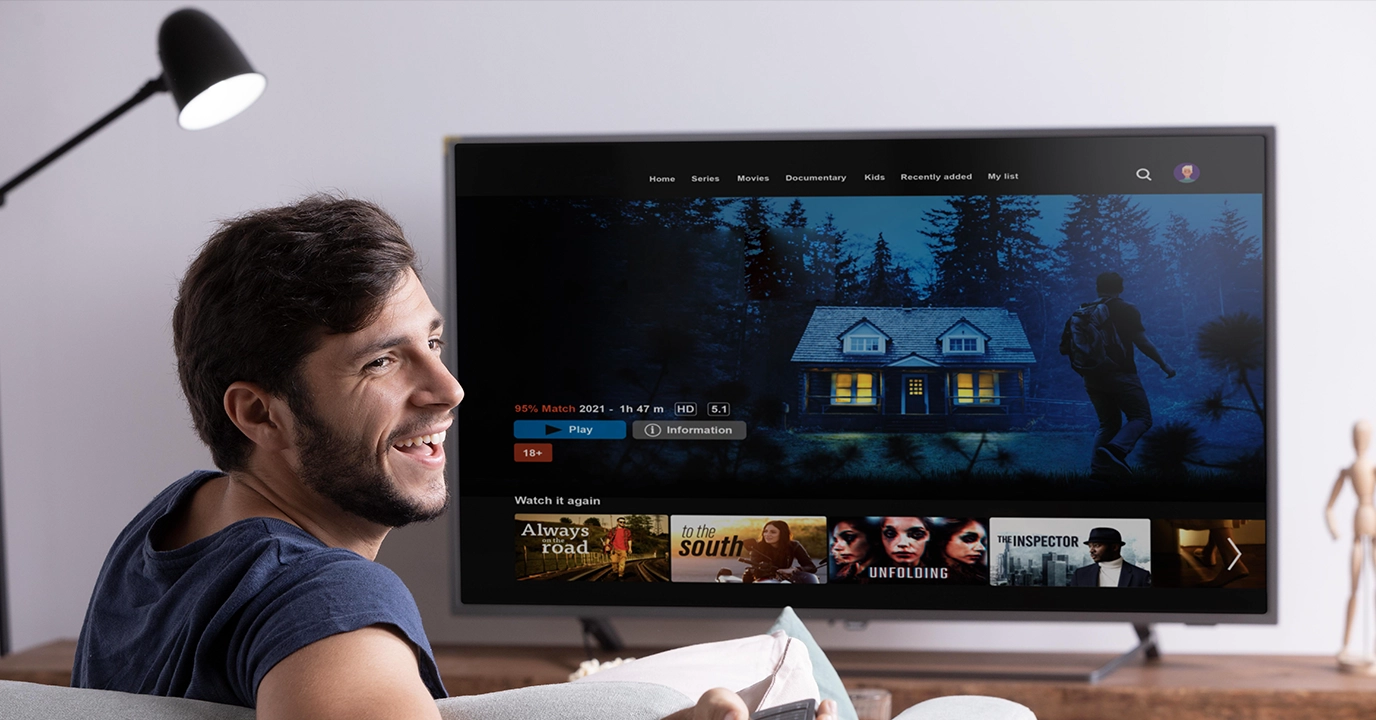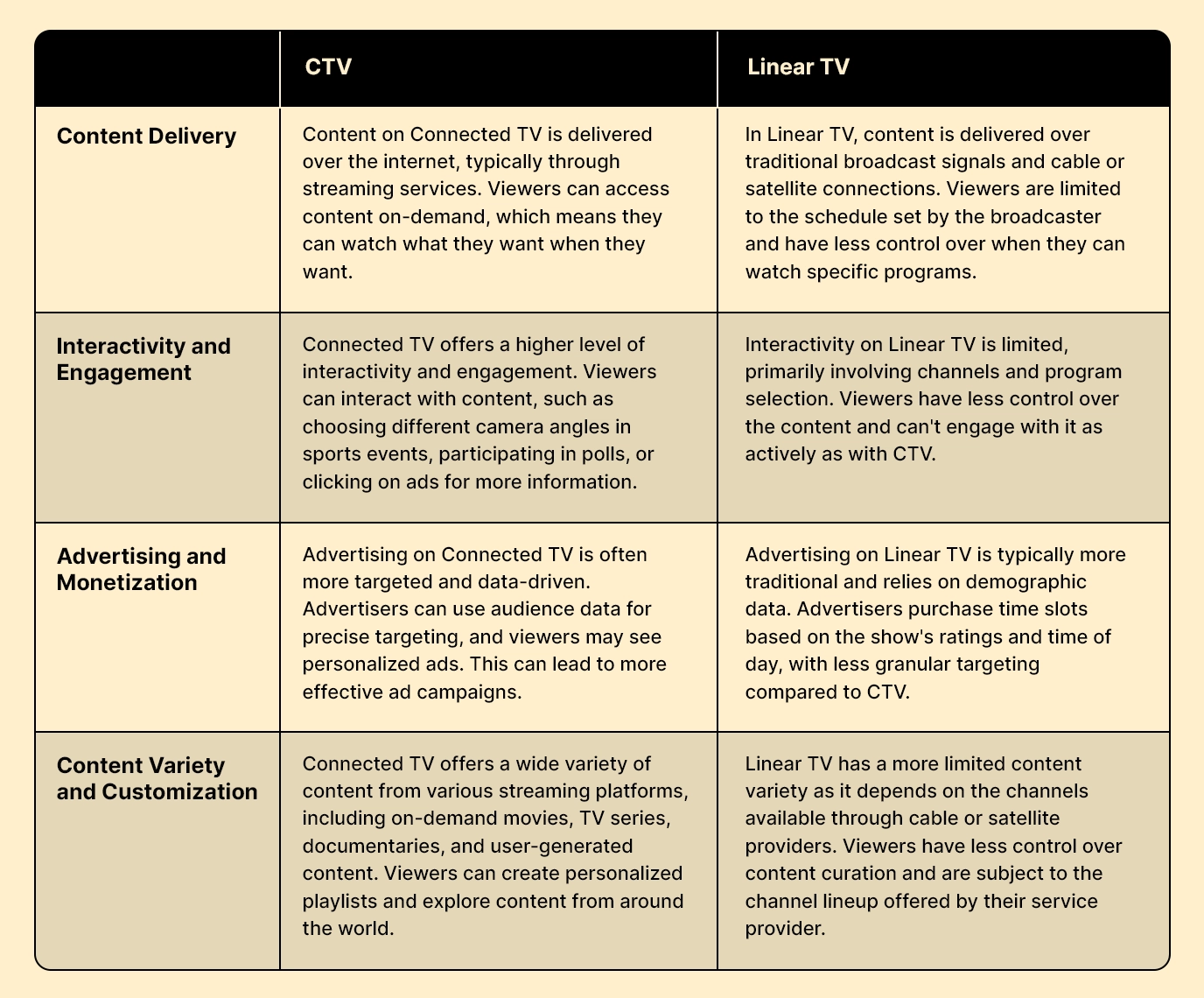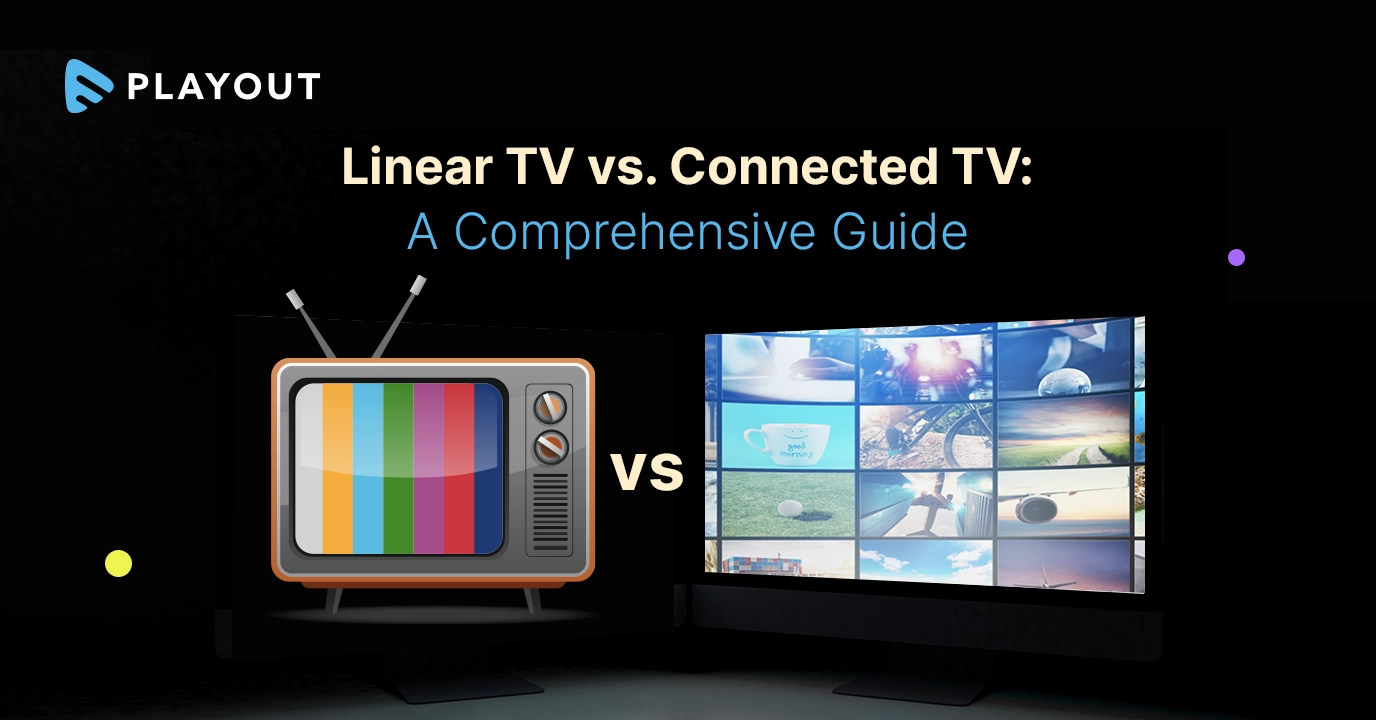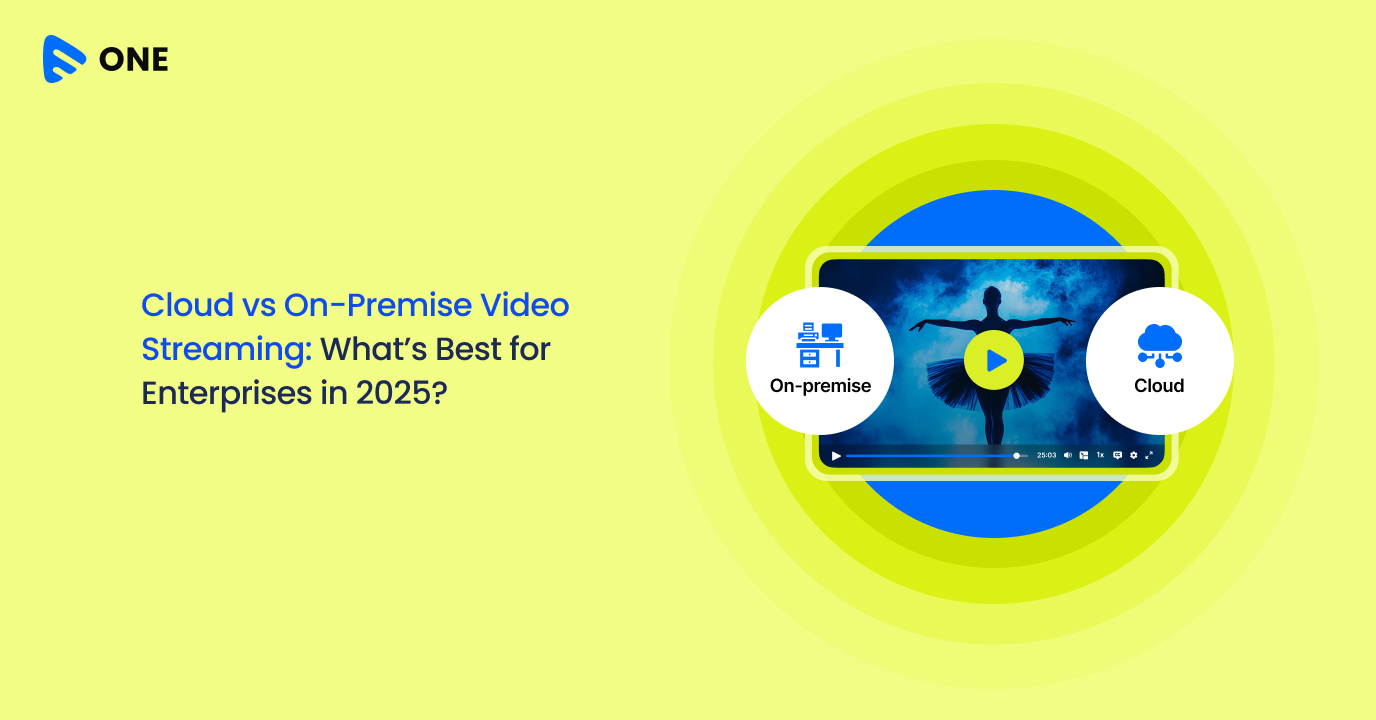The age-old tradition of tuning in to scheduled broadcasts on your living room screen has found itself in a head-to-head clash with the dynamic and customizable world of streaming services and on-demand content.
CTV or connected TV has become a leading pillar in the streaming TV industry. With more household audiences, choosing to cut the cord and prefer CTV as a medium for scheduled content consumption has changed the entire landscape and has made CTV the fastest growing medium.
What is Linear TV?

Linear TV, often referred to as traditional or broadcast television, is a television broadcasting format in which television programs are scheduled and delivered to viewers in a predetermined, fixed sequence. In linear TV, viewers have limited control over the timing of the content they watch. They must tune in at specific times to watch their desired programs, as these programs are broadcast according to a set schedule.
Key Characteristics of Linear TV
- Scheduled Programming: Linear TV networks have a predetermined schedule that lists the times and dates when specific shows, movies, news broadcasts, and other content will air. Viewers need to be aware of these schedules to watch their favorite programs.
- Limited Control: Viewers have limited control over when they can watch content. They must be available and tuned in at the exact broadcast time to catch a particular show or event.
- Commercial Breaks: Linear TV often includes commercial breaks, which provide advertisers with opportunities to reach a broad audience. These breaks are typically scheduled during natural pauses in the programming.
- Over-the-Air and Cable/Satellite Distribution: Linear TV can be delivered through over-the-air broadcasts using antennas or through cable and satellite TV services. Viewers typically need specialized equipment and subscriptions to access these channels.
- No On-Demand Features: Linear TV does not offer on-demand features like pausing, rewinding, or fast-forwarding content. Viewers must watch programs as they are broadcast, with no ability to control playback.
What is Connected TV (CTV)?

Connected TV (CTV), also known as Smart TV or Internet TV, refers to television sets or devices that are connected to the internet, allowing users to access a wide range of digital content beyond traditional broadcast and cable television. CTVs are equipped with internet connectivity features, such as built-in Wi-Fi or Ethernet ports, and they often run on operating systems that enable the installation of various apps and streaming services.
Key Characteristics of CTV
Internet Connectivity: Connected TVs can access the internet, enabling users to stream content, browse the web, and interact with online services.
- Streaming Services: Users can access a variety of streaming services to watch on-demand movies, TV shows, and original content.
- Apps and Games: Connected TVs often have their own app stores, allowing users to download and install apps for a wide range of purposes, such as social media, gaming, news, and productivity.
- Social Media Integration: Many CTVs integrate with popular social media platforms, allowing users to share content, check notifications, and stay connected with friends and followers.
- Voice and Gesture Control: Some CTVs support voice or gesture control, making it easier to navigate menus and search for content.
- Screen Mirroring: Users can mirror the screens of their mobile devices, such as smartphones and tablets, on the TV for content sharing and presentations.
- Personalization: CTVs often provide personalized recommendations based on viewing history and preferences, helping users discover new content.
- Interactive Content: Some CTVs offer interactive content, such as quizzes, polls, and real-time updates, enhancing the viewer’s engagement.
What is OTT?

OTT stands for “Over-The-Top,” and it refers to the delivery of content, such as movies, television shows, and other video or audio material, over the internet, bypassing traditional cable or satellite TV services. OTT content is typically delivered directly to consumers via streaming media services over the internet. These services are called OTT platforms or OTT streaming services.
OTT services have become increasingly popular in recent years and have transformed the way people consume media. They offer a wide range of content that can be accessed on various devices, including smartphones, tablets, smart TVs, and computers. Popular examples of OTT platforms include Netflix, Amazon Prime Video, Hulu, Disney+, and YouTube.
Key Characteristics of OTT
- Internet-Based Delivery: OTT content is delivered over the internet, allowing users to access it on various devices connected to the web, such as smartphones, tablets, smart TVs, and computers.
- On-Demand Access: OTT services offer on-demand access to a vast library of content, including movies, TV shows, and original programming. Users can choose what they want to watch and when they want to watch it, providing a high degree of flexibility.
- Content Variety: OTT platforms provide a wide range of content, including movies, TV series, documentaries, live sports, news, and user-generated content. They cater to a diverse set of interests and demographics.
- Subscription Models: Many OTT services operate on a subscription-based model, where users pay a monthly fee for access to content. This contrasts with traditional cable or satellite TV, which often require long-term contracts.
- Ad-Supported Options: Some OTT services offer free, ad-supported content as an alternative to subscription-based models. Users can access a limited selection of content with advertisements.
- Original Content: OTT platforms often produce their own original content, including movies, TV series, and documentaries. These exclusive offerings can be a major draw for subscribers.
- Personalization: OTT services use algorithms and user data to provide personalized recommendations and content discovery. This helps users find content tailored to their preferences.
- Cross-Device Compatibility: OTT platforms are accessible on various devices, making it easy for users to switch between smartphones, tablets, smart TVs, and computers while maintaining a consistent viewing experience.
- Global Reach: Many OTT services are available internationally, giving users access to a global library of content. This has made it possible for viewers to explore content from around the world.
- Streaming Quality: OTT services typically offer high-quality streaming, often in high-definition (HD) or 4K resolution. The quality of the stream may adjust based on the user’s internet connection.
- Offline Viewing: Some OTT platforms allow users to download content for offline viewing. This is useful for travelers or those with limited internet connectivity.
- User Profiles: OTT platforms often support multiple user profiles within a single account, making it easy for different family members to maintain their preferences and watch histories.
- Interactive Features: Some OTT content is interactive, allowing viewers to make choices that influence the storyline, particularly in the case of interactive movies and TV series.
- Multi-Platform Apps: OTT providers offer apps for various operating systems, making it easy for users to access content on their preferred devices.
- Flexible Pricing: OTT services may offer different pricing tiers with varying levels of content access, including family plans or premium subscriptions with additional features.
- No Geographical Limitations: OTT services often have a global presence, meaning users can access content from anywhere in the world, provided they have an internet connection.
- Recommendation Engines: Many OTT platforms use sophisticated recommendation algorithms to suggest content based on a user’s viewing history and preferences.
Differences Explained: CTV Vs Linear TV


What are the Benefits of CTV?

Flexibility and Convenience:
CTV provides viewers with the flexibility to watch content on their own schedule. They can access streaming services and apps on their smart TVs or other devices, allowing them to choose when and what they want to watch. This convenience is a major advantage over traditional TV schedules.
Content Variety:
CTV platforms offer a wide range of content options, including on-demand streaming services, live TV channels, and user-generated content. This variety caters to diverse tastes, ensuring that viewers can find content that interests them.
Targeted Advertising:
Advertisers can leverage user data and advanced targeting capabilities on CTV platforms to reach specific demographics and interests. This means that ads are more likely to be relevant to the viewer, increasing the chances of engagement and conversion.
Measurable Performance:
CTV advertising provides advertisers with detailed analytics and metrics, allowing them to measure the performance of their ad campaigns accurately. Advertisers can track metrics such as ad views, click-through rates, and conversions, enabling data-driven decision-making and optimization.
Interactive and Engagement Features:
CTV often supports interactive features, such as clickable ads or interactive overlays. This interactivity can engage viewers and enhance the overall ad experience. For example, viewers can click on an ad to learn more about a product or service or participate in interactive polls and surveys.
Ad Skipping Prevention:
Unlike traditional TV where viewers can easily skip ads, CTV platforms offer more control to advertisers. While ad skipping is still possible in some cases, CTV platforms may employ techniques to discourage or limit this behavior. Advertisers can use interactive and engaging ad formats to make viewers less likely to skip the content.
What are the Benefits of Linear TV?
Linear TV, also known as traditional television, offers several benefits that continue to make it a popular choice for viewers despite the rise of on-demand and streaming services. Here are the explanations for the benefits you mentioned:
Scheduled Programming:
Linear TV provides a set schedule of programming, which can be convenient for viewers who prefer a structured viewing experience. This allows people to plan their TV-watching routines, making it easier to anticipate when their favorite shows or events will air.
Live News and Sports:
Linear TV is an excellent source for live events, such as breaking news, sports games, and special broadcasts. It offers real-time coverage of events as they happen, providing an immediacy that on-demand services may not always offer.
Simplicity and Ease of Use:
Linear TV is user-friendly and straightforward. Viewers can simply turn on the TV and start watching without the need for technical skills or navigating complex menus. This simplicity is appealing, especially to older audiences who may not be as tech-savvy.
Local and Regional Content:
Linear TV often features local and regional content, including news, events, and community-specific programs. This makes it an essential source for staying connected with local happenings and culture.
Variety of Channels:
Linear TV typically offers a wide range of channels catering to various interests and demographics. Viewers can access a diverse selection of content, from entertainment and lifestyle channels to educational and documentary networks.
Advertising Revenue:
Linear TV relies on advertising revenue to support its operations. This benefits businesses and advertisers looking to reach a broad audience, as they can air commercials during popular shows and events to maximize their exposure.
Channel Surfing:
Channel surfing is the practice of rapidly switching between different TV channels to find content of interest. Linear TV encourages this behavior, allowing viewers to stumble upon shows or events they might not have considered watching otherwise. It can be a fun and spontaneous way to discover new content.
Summing it up
While CTV and OTT are related concepts, they pertain to distinct aspects and should not be conflated. “CTV” pertains to the streaming devices used for video content, whereas “OTT” relates to the method of delivering content. In contrast, linear TV primarily relies on cable, satellite, and antenna technologies to provide live streaming channels and on-demand content.
Create Your Own Cloud based Linear TV Channel with Muvi Playout!

Muvi Playout is a cloud playout software for Linear TV channels that helps you Schedule, launch and manage your cloud based linear TV channel. It helps you gain global exposure, expand revenue streams, and build a loyal audience. With Muvi Playout, it is easy to launch customizable online TV channels seamlessly.
What can you do with Muvi Playout?
Create FAST channels –
Muvi allows you to create and manage online FAST Channel (free ad-supported linear streaming) and monetize them with video playout software.
Online TV Channel –
Muvi Playout helps you seamlessly set up a live stream and on-demand content delivery channel for your internet TV using video playout software.
Online Radio Stations –
Muvi Playout also helps you set up and start an online radio station in minutes, and switch between live audio streaming and pre-recorded content with ease.
How is Muvi Playout Different From Other Cloud Playout Vendors?
What sets Muvi Playout apart from other cloud playout providers is its all-encompassing video playout software, which empowers broadcasters to effortlessly handle and transmit their content. In contrast to conventional cloud playout vendors, Muvi Playout provides a user-friendly drag-and-drop scheduler, a versatile multi-channel playout system, customizable workflows, real-time monitoring, seamless bulk content uploading, and cutting-edge automation features, all designed to elevate the user’s experience. Take a free trial to find out how easy it is to start an online TV channel with Muvi Playout!
























Add your comment